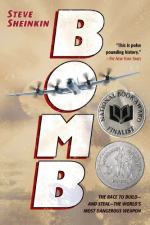|
This section contains 1,370 words (approx. 5 pages at 300 words per page) |

|
A bomb is conventionally an encased explosive or chemical, triggered by a fuse or by impact, that is used in warfare. Bombs can be flung by hand or through a barrel, propelled by a rocket, carried within a missile, dropped from an aircraft, or left in the ground or water as mines. In addition, bombs take effect in various ways: through fragmentation, which scatters bullet-like fragments such as shrapnel; through the heat and fire of incendiary bombs; through the destructive surge of air called the "blast"; through the suction after-effect of this displaced air; and through shock, which can convulse the earth, buildings, and water.
The history of bombs, intertwined with the history of war, extends far back in time. Catapults, which projected stones, arrows, or incendiary mixtures generally based on tar, date back to antiquity. The relatively late, petroleum-based incendiary mixture known as "Greek fire" was apparently...
|
This section contains 1,370 words (approx. 5 pages at 300 words per page) |

|


